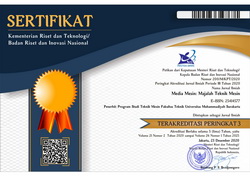PERKEMBANGAN CACAT RONGGA PADA PROSES EKSTRUSI
Tri Widodo Besar Riyadi(1*)(1)
(*) Corresponding Author
Abstract
Cavity defect occurs in an extruded product when the remaining billet reaches a certain thickness. This defect can create serious problem in the quality of products because it produces waste material and requires an extra operation for finishing. The requirement of wasting a certain portion of the product becomes undesirable especially for a relatively short, headed product. Since the occurrence of this defect is troublesome in industrial practice, it is important to study the conditions leading to the cavity formation. By using this prediction, it may be possible to stop the process before the cavity starts to develop. In this work, a new measuring technique to monitor the development of cavity defect in forward extrusion was studied. This technique uses electrical contact principle, which detects the contact between metal pins and the leading face of the billet. When the cavity develops, a void or gap between the punch and the billet interface develops, and breaks the electrical current of the circuit. The experiment of extrusion process was undertaken in parallel with a finite element analysis (FEA) using ABAQUS software. It was shown that at a certain distance the cavity defect was revealed. In this work, the cavity formation was investigated by a variation of die reduction. The influence of coefficient of friction, punch speed, and billet thickness was also observed. This study concentrated on improving the understanding of the behavior of metal flow and the development mechanism of cavity formation with the aim of providing general guidance for the extrusion industry in minimizing the cavity defect formation of the extruded product.
Full Text:
PDF (Bahasa Indonesia)References
Johnson, W., 1955, Further Experiments in Plane Strain Extrusion, B.I.S.R.A. Reports MW/E/49/55.
Atkinson, J., 1972, An Investigation of the Coring Defect during Forward Extrusion of Lead, M.Sc Dissertation, Mechanical Engineering Department, UMIST.
G. Li, dkk, 2001, Recent development and applications of three-dimensional finite element modeling in bulk forming processes, J. of Material Processing Technology 113, 40-45.
Tri Widodo Besar Riyadi, 2004, Characterization of Cavity Defect Forward Extrusion, MSc Dissertation, UMIST, UK.
Serope Kalpakjian, dan Steven R. Schmid, 2003, Manufacturing Process for Engineering Material, p.23, Pearson Education, Inc., Prentice Hall.
Article Metrics
Abstract view(s): 483 time(s)PDF (Bahasa Indonesia): 318 time(s)
Refbacks
- There are currently no refbacks.








